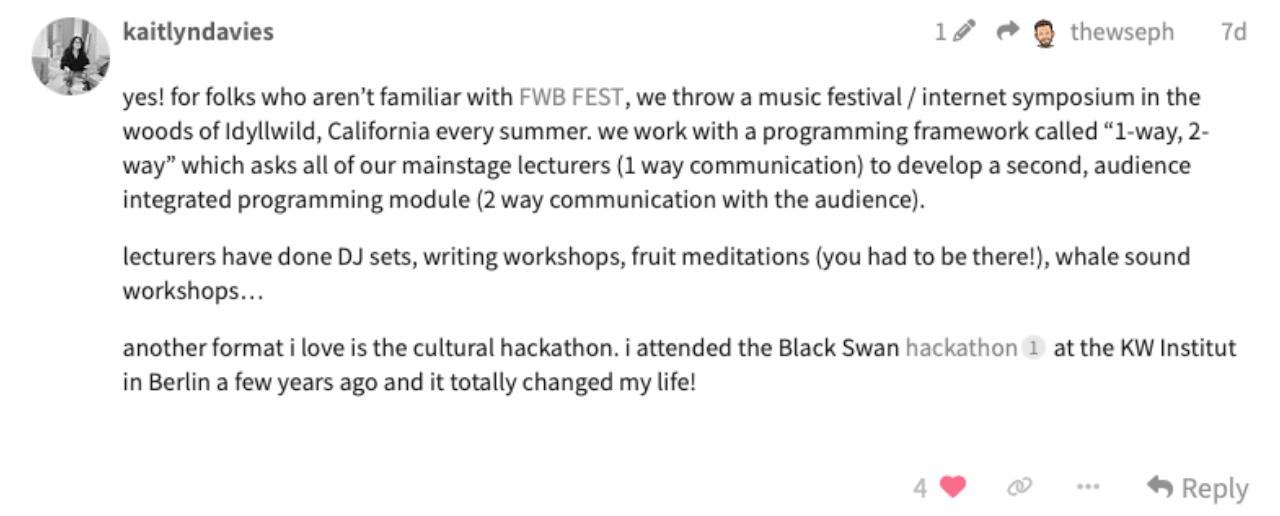Research Raves
For our last SEED of the year, we explore why brands are throwing raves and ask what kind of research can emerge from these spaces of ecstatic participation?

We live in a world so saturated with media that we’ve become experts in what I call waste separation. Most of what floods our retinas is excess, and we’ve learned to recognise the signs.
Take email, for instance. I’d estimate that 80-90% of the emails we receive come from brands or companies that are inauthentically trying to cut through the noise. By creating a false sense of belonging and mimicking a personable tone – such as using subject lines and pre-headers like “Hi [First Name], we miss you” or “OMG, have you seen this?” – some brands manage to trick the average person-turned-expert into clicking. As a result, we have all grown a thick skin that cannot easily be permeated.
Ironically, it’s often the very companies trying to cut through the noise who have caused us to put our guards up – a prime example of capitalism’s inherent tendency to destabilise itself. As the critical theorist Nancy Fraser puts it in The Old Is Dying and the New Cannot Be Born (2019), it’s “like a tiger eating its own tail”. When corporate companies such as BMW started changing their logos to rainbow flags during Pride month, but do little else to publicly support LGBTQ+ rights throughout the year, it’s clear that there’s yet another waste flow that needs to be separated from truly inclusive and progressive causes.
Unfortunately, the constant drive for attention-grabbing content and social-media baiting has eroded our tolerance for genuine messages from friends and family. The urge to “switch off” and binge-watch Netflix – an activity that has seamlessly moved from laptops at home to smartphones on the go in recent years (quietly killing “social” time) – becomes much greater in times of permanent exhaustion. With messages now appearing on the same screen, they often feel like just another disruption to our already dwindling leisure time. And while we may crave authentic connections, our capacities for them are depleted.
Tapping into the growing desire for authenticity in an era where binge culture has gone truly mobile, brands are scrambling to do more than just sell products. In our recent Brands as Libraries SEED, it was suggested that thinking like a library is the way forward for brands. By opening up their archives and making their story and ways of working visible in an unpolished, more authentic way, brands can create a sense of community that goes beyond the conventional seller-customer relationship. Expanding on this idea in Consider the Curator, writer Jack Stanley argued, “Whether it’s acting as a library, filled with books and references, or becoming something closer to an art gallery, both ways help to display the cultural meaning the brands are trying to attach to their product.”
The relatively recent trend of brands curating their own raves feels like another step in the same direction. Elsewhere referred to as “rave’s overground rivals”, many of these brand-driven events echo the same breadcrumb-style teasers – via WhatsApp, Telegram, Instagram and other platforms – that characterised the original 90s rave scene, where phone calls to a payphone near a motorway pitstop outside London were the key to finding the party.

Heidi Mumford, shared this list in our contributors forum to show a range of brands hosting their own raves:
Carhartt · Rick Owens · Diesel · G-Star · Levi’s · Red Bull · Moncler · Balenciaga · Run n’ Rave · Champion
With large numbers of grassroots venues and nightclubs in the UK forced to shut down since 2006 – not helped by the pandemic, which only highlighted the importance of dancing together in real life to combat isolation – it is evidently brands who are stepping into the void. Aiming to mimic the early 90s movement and club culture, these physical events often lack genuine integration with, or understanding of, the subculture’s values and beliefs. Prompting the question: Is this another waste stream opening up?
Fellow contributor, Valentina Palange, then raised an intriguing question about whether these “corporate raves” could be seen as an example of what the French philosopher Jean Baudrillard described as simulacra in society. According to Baudrillard, a simulacrum is an entity that replaces reality with its own representation. As the online world continues its Sisyphean attempt to eclipse the offline world – and, with it, our inconvenient, mortal bodies – there are now more representations of a once-lived reality than there is any guarantee of the “real thing” existing in the future.
Meanwhile, in the lands of academic research, clunky and antiquated in comparison, there has been a scramble to keep up with the Brandashians. From the early 2000s onwards, with the emergence of sophisticated information-based capitalism and digital culture, disciplines such as sociology have seen themselves plunged into a crisis of empirical methodological research. The social scientists Mike Savage and Roger Burrows argued, in 2007, that empirical sociology is overshadowed by the capacity of industry and commerce to know patterns of behaviour and taste in more sophisticated ways than sociologists and social researchers, through freelancer fact-makers who work at policy think tanks and corporate research. They cite the capacity of Amazon to almost automatically anticipate what we like and want to buy next. This crisis, however, also offered the opportunity for sociology to reinvent itself, for example by redefining its role alongside tech giants such as Amazon.
As these are not concerned with thick description or sustained critical attention, social researchers saw themselves better placed to describe that which is not paid attention to: “through a radical mixture of methods coupled with renewed critical reflection” (Savage and Burrows). Methods then moved from the dated sample survey and in-depth interviews to more inventive and multi-sensory realms that focused on making the body a central part of the research – as a working against the reinforced mind/body-divide of the early cyberspace years.
We are more than what we buy online; we are more than data. This is where all sorts of practice-based research methods have blossomed into rich material for the Creative Humanities, which has made research more accessible to all. Of course, there is the criticism of academia as self-superior or too distant from the “real world”. It can also equally be “misused to create hierarchy or divisions of prestige, for example by using overly convoluted and jargonistic language,” as noted in Sonic Rebellions: Sound and Social Justice, a book edited by Wanda Canton.
But practice-based research methods, such as using “glitter workshops” to explore how girls imagine their futures, and multi-sensory research presentations shared in public exhibitions, can break down barriers and help diversify academia.
In fact, sociologists often draw on the arts to develop more inventive and creative methods. Les Back, former Director of the Centre for Urban and Community Research at Goldsmiths College, London, has argued for using music as a way to practice sociology. He draws a parallel between the attentiveness required in music and sociological research, both of which seek to make sense of seemingly incoherent or chaotic elements. So, while the internet’s existence creates more and more representations of (formerly) real things and experiences, (sociological) research moves more and more into the other direction, trying to eclipse the distance between representation and reality. As the sociologist John Law has said: If this [anything in the social world of the 21st century really] is an awful mess, then wouldn’t something less messy make a mess of describing it?”
This led me to consider music itself as a form of research. As a DJ, I’ve always been drawn to the immediacy of making people dance. Sharing and experiencing music together has also been a powerful way for me to express myself and my inner life, beyond cultural and social markers like skin color. To explore how “music as research” might work in practice, I looked to visual artists such as Adrian Piper, Lotte Andersen, Max Grau and Roland Carline, who integrate music and/or dance into their work to explore or reflect on different socioeconomic experiences.

I was also reminded of Kent Chan’s 2023 exhibition, Future Tropics, at London’s Gasworks. The show featured DJ sets from various tropical regions – Brazil, Kenya, India and Indonesia – projected across four screens. The immersive experience invited viewers to reflect on the complex interplay between climate, culture and the broader societal impacts of environmental change.

This taps into the importance of working in interdisciplinary ways, successfully applied by the research agency Forensic Architecture, who operate across human rights, journalism, architecture, art, aesthetics, academia and law. With the move towards a post-Anthropocene, where we actively see ourselves as parts of the environment and in equal partnership with non-human agents, the rise of audio investigation and listening practices offers counterstrategies of social and environmental mapping that can detect phenomena, which may otherwise stay hidden. Further cementing the value of listening methodologies is the sound theorist and artist, Brandon LaBelle, who asks: “In a world dominated by the visual, could contemporary resistances be auditory?” (2018).
What might academic research learn from incorporating these elements into its practice-based research methods? And isn’t throwing research raves a direct response to brands throwing raves, but with the premise of authenticity?
The cultural critic Diedrich Diederichsen brings home the importance of vibrant research: “It is only when I am ecstatic, outside of myself, that I can be with everyone, that I can float in a sense of potential.” By creating research environments that don’t just bridge the gap between reality and its representation, but that offer spaces where participants can shed their self-awareness and enter into a state of full bodily integrity, research can become even more relevant in today’s age of brands.
Festivals such as by Sonic Acts (an interdisciplinary arts organisation based in Amsterdam), Sonic Rebellions (a two day symposium featuring film screenings, interactive workshops and live music performances) and FWB Fest (see below from Kaitlyn another one of our contributors) are inspiring concepts for future versions of research raves.

Rather than traditional symposiums or conference formats held on university campuses or at clubs funded by student fees, research raves could emerge as a new model. These would involve individual research projects organising raves that are thematically tied to their research topics, potentially gathering qualitative data in the process. Of course, the research environment would need to remain sober, aligning with another growing trend – the sober rave, which has been dubbed “the party of the future” – unless, of course, the research topic dictates otherwise.
It’s fascinating to consider how online brand identities can foster real-world connections without one undermining the other. Additionally, it will be interesting to observe how universities embrace the counter-quest for critical engagement, shifting from “corporate raves” to “research raves”. The key question will be: what kind of research can emerge from these spaces of ecstatic participation?
| SEED | #8284 |
|---|---|
| DATE | 19.12.24 |
| PLANTED BY | CAROLIN MEYER |
| CONTRIBUTORS | VALENTINA PALANGE, HEIDI MUMFORD, KAITLYN DAVIES |



Discussion